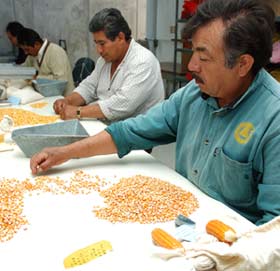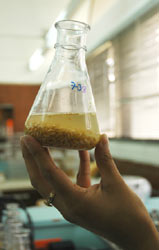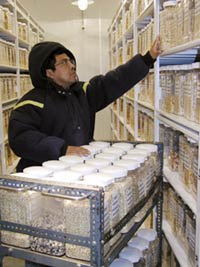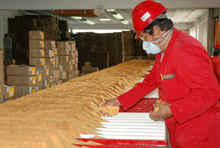The journey of a seed
 Seed is the lifeblood of CIMMYT research and partnerships. Behind the scenes at CIMMYT, many thousands of seeds are on the move. Constantly arriving and departing as seed is shared with partners, they may journey through rigorous health testing in the laboratory, planting in the soils of the center’s research stations, or storage in the icy vaults of the germplasm bank.
Seed is the lifeblood of CIMMYT research and partnerships. Behind the scenes at CIMMYT, many thousands of seeds are on the move. Constantly arriving and departing as seed is shared with partners, they may journey through rigorous health testing in the laboratory, planting in the soils of the center’s research stations, or storage in the icy vaults of the germplasm bank.
No man is an island, and CIMMYT, as the world center for maize and wheat research, certainly isn’t. The center’s lifeblood is genetic variability: it is preserved in the germplasm bank; useful genes derived from it are incorporated in new varieties and shared with partners. These genes come packaged up in seeds, and countless seeds enter and leave CIMMYT every year, traveling to and from far-flung destinations including breeding programs of national agricultural research systems and private seed companies, CIMMYT’s global network of offices, and its research stations within Mexico.

Seed arriving at CIMMYT-Mexico must pass through strict testing procedures in the Seed Health Laboratory (SHL), part of the Seed Inspection and Distribution Unit (SIDU). “For Mexico we represent a risk—we’re unique in importing seed from all over the world,” says Monica Mezzalama, seed health expert and plant pathologist in charge of the SHL. “We have a duty towards Mexico and our collaborators in other countries to make sure we are not distributing seed with diseases. It’s also important for seed quality—we send people our best material.”
Staff in the SHL test seed for insects, weeds, fungi, bacteria, and viruses (see photo slideshow). The lab routinely checks for pathogens under quarantine for Mexico and for partner countries. Seed that gets a clean bill of health—a “seed release”—moves on, often going to a breeder, whereby its potentially useful traits may enter improved varieties. Alternatively, it may be headed for another lab and more testing by scientists working on seed quality or micronutrient content. Finally, many seed samples are destined for storage in the seed bank.
Entering the vaults
On behalf of humankind, present and future, CIMMYT holds enormous collections of seed of wheat and maize, as well as of the crops’ wild and cultivated relatives. For Tom Payne, head of the wheat germplasm bank (seed bank), the focus is on useful diversity, particularly from materials that have already undergone some breeding. “The most valuable germplasm (genetic material or seeds) is the germplasm we know the most about. It lets you look for the traits you’re interested in,” he says. Nonetheless, Payne says that breeders also recognize the value of landraces—traditional farmer varieties—and wild relatives: “When Ug99 (a new, highly-virulent form of stem rust) broke out in Africa, we sent 4,000 randomly-selected landraces for screening and found new sources of resistance.”
In the case of wheat, once cleared by the SHL, seed of new samples for the germplasm bank goes into several packets with different destinations. At least 200 grams will enter the “active” collection, from which external requests for seed are met. Additional packets are prepared for long-term storage at CIMMYT and, finally, three partner banks as back-ups. Because the center normally receives small amounts of seed, it has to be grown out, or “multiplied,” to harvest enough for research, storage, and back-up purposes. Seed is also multiplied for distribution. Again, quarantine precautions require that new wheat seed first be grown at the center’s headquarters and then vetted by the SHL, after which it travels 2,500 kilometers north to be re-sown at a Mexican desert location certified as free from the diseases. The final product is shipped back to CIMMYT headquarters and once more inspected by the SHL.

Regenerating germplasm bank collections
Eventually seed in the germplasm bank ages and begins to lose its ability to germinate. Also, supplies of frequently-requested samples eventually run short. When either occurs, viable seed from the sample is sown to replenish the collection—a process known as “regeneration.” “In 2008, the germplasm bank regenerated a record 18,000 wheat lines,” says Bibiana Espinosa, the principal research assistant who manages CIMMYT’s wheat germplasm collection. “That’s 45% more than in typical years.”
Pollen from a single maize plant can fertilize seed of many neighboring plants, so regeneration of maize seed is more costly and complex than for wheat plants, which are self-fertilizing. Maize crosses must be carefully mapped out and controlled to ensure that the diversity from the original sample is as closely replicated as possible. “Regenerating and storing one sample of maize costs around USD 250 or more—maybe 20 times more than a sample of wheat,” says Payne. “On a single hectare of land you can regenerate thousands of wheat lines, but because individual maize populations or landraces may embody tremendous genetic diversity, they require far more space to regenerate properly.”
Keeping track of hundreds of thousands of seed collections poses a serious challenge for germplasm bank staff. CIMMYT has recently begun marking seed packets with a barcode linked to crop database systems for physical and molecular traits. “The goal is to internet-enable all these databases and link to specific seed collections in the bank, helping people make selections,” says Payne.
Seed collections and genetically modified crops
“CIMMYT’s internal policy is to avoid the involuntary presence of transgenes in its germplasm,” says Mezzalama, referring to genes from other species that are introduced into crop plants like maize using genetic engineering. This means strict monitoring of maize seed that the center introduces from abroad, either for storage in the bank or for breeding purposes. As a further measure, regeneration plantings are surrounded by “sentinel plots” from which seed is harvested and tested in the laboratory to check for the possible arrival of foreign pollen.
On the road again
All seed in the germplasm bank has been certified as clean by the SHL, so it is always ready to be planted in the field or sent to anyone who requests it. However, like any traveler, it must carry a passport—an international phytosanitary certificate—to move between countries. In addition, CIMMYT seed travels only if prospective recipients accept the “Standard Material Transfer Agreement”—which stipulates among other things that the seed may not be sold or patented, and was adopted in the first session of the Governing Body of the International Treaty on Plant Genetic Resources for Food and Agriculture.

Every year, SIDU receives hundreds of requests for samples of bank or breeding seed. CIMMYT also ships annual international nurseries (for wheat) and international trials (for maize). These are collections of the center’s best materials, grouped into sets for specific aims: high yield, heat tolerance, disease resistance, to name a few. Partners request sets, grow out and evaluate the experimental seed, and return data on the results to CIMMYT. The center collates and analyzes the data from all sources, publishes and distributes the results to partners, and uses the information to guide subsequent breeding efforts. Partners who grow the trials may keep and use seed of the varieties that interest them, or request additional seed.
Efrén Rodríguez, who is responsible for seed distribution, estimates that public research organizations make up around two-thirds of CIMMYT seed recipients; the rest are private sector seed companies. “In many countries requests from small seed companies are increasing as the sector grows, for example in Mexico and India,” he says. In wheat, 70–80% of requests are for international nursery material, whereas in maize about 70% are requests for materials from the germplasm bank. “We have around 500 CIMMYT inbred maize lines, and all the seed companies want a sample of these lines to use in their breeding programs,” says Rodríguez. His team can count partners in around 150 countries, and in a year meets around 800 requests for seed.
Most of this work by SIDU and the germplasm bank goes unnoticed by the casual visitor, but, says Mezzalama, “…the daily contact with people around the world who really need CIMMYT seed makes me feel very confident that I’m doing something valuable.”
For more information:
Tom Payne, Head, Wheat Genetic Resources (t.payne@cgiar.org);
Monica Mezzalama, Head, Seed Health Laboratory (m.mezzalama@cgiar.org)